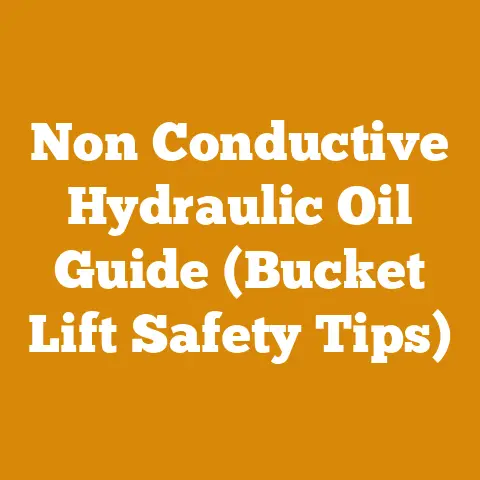Chainsaw Pants or Chaps (5 Expert Safety Tips)
Chainsaw Pants or Chaps: 5 Expert Safety Tips
When I first started felling trees, I thought I was invincible. Armed with a brand-new chainsaw and a whole lot of bravado, I charged into the woods, ready to conquer any timber that stood in my way. It wasn’t long before I realized I was sorely mistaken. Chainsaws are powerful tools, and without the right safety gear, you’re playing a dangerous game. That’s why I’m here to talk about chainsaw pants and chaps – your first line of defense against a potentially devastating injury. In this article, I’ll share five expert safety tips to help you choose the right gear and use it effectively, so you can stay safe while working with your chainsaw.
I’ll break down the differences between chainsaw pants and chaps, explain how they work, and provide practical advice on selecting the right fit, material, and style for your needs. I’ll also cover essential maintenance tips to keep your protective gear in top condition. By the end of this article, you’ll have a clear understanding of how to protect yourself and minimize the risk of injury when operating a chainsaw.
1. Understanding the Basics: Chainsaw Pants vs. Chaps
Before diving into the specifics, let’s clarify the difference between chainsaw pants and chaps. Both are designed to provide protection against accidental chainsaw contact, but they do so in different ways.
Chainsaw Chaps:
- Coverage: Chaps are leg coverings that extend from the upper thigh to the boot. They typically attach around the waist with adjustable straps or buckles.
- Protection: Chaps are designed to be worn over your regular work pants. They offer a layer of protection that can stop or slow down a chainsaw chain in the event of contact.
- Convenience: Chaps are easy to put on and take off, making them a convenient option for occasional chainsaw users or those who need to switch between tasks frequently.
- Cost: Chaps are generally less expensive than chainsaw pants, making them an accessible option for budget-conscious users.
Chainsaw Pants:
- Coverage: Chainsaw pants are designed as regular work pants with integrated protective layers. They offer full leg coverage, including the front, sides, and sometimes the back of the legs.
- Protection: Chainsaw pants provide a higher level of protection than chaps due to their full coverage and integrated design. They are ideal for professional loggers or those who use chainsaws extensively.
- Comfort: While early chainsaw pants were stiff and uncomfortable, modern designs prioritize comfort with features like articulated knees, breathable fabrics, and adjustable waistbands.
- Cost: Chainsaw pants are typically more expensive than chaps due to their more complex construction and higher level of protection.
How They Work: The Science Behind the Protection
The protective mechanism in both chainsaw pants and chaps relies on layers of loose, strong fibers, typically made of materials like ballistic nylon or Kevlar. When the chainsaw chain comes into contact with these fibers, they are drawn into the saw’s mechanism. The fibers then clog the sprocket, causing the chain to slow down or stop almost instantly.
- Fiber Type: Ballistic nylon is a durable, synthetic fabric known for its high tensile strength and abrasion resistance. Kevlar is an even stronger synthetic fiber that offers exceptional cut resistance.
- Layer Count: The number of protective layers varies depending on the level of protection offered by the pants or chaps. More layers generally provide greater protection but can also increase weight and reduce breathability.
- Fiber Orientation: The orientation of the fibers within the protective layers also plays a crucial role. Fibers are often arranged in multiple directions to ensure that they can effectively snag the chain regardless of the angle of contact.
2. Understanding Protection Levels & Standards
Not all chainsaw pants and chaps are created equal. They are classified based on their level of protection, which is determined by their ability to stop a chainsaw chain at specific speeds.
European Standards (EN 381/EN ISO 11393):
- Class 0: Designed to stop a chain speed of 16 m/s (3150 fpm). Suitable for light-duty tasks and occasional users.
- Class 1: Designed to stop a chain speed of 20 m/s (3940 fpm). The most common protection level, suitable for general forestry work.
- Class 2: Designed to stop a chain speed of 24 m/s (4720 fpm). Recommended for professional loggers and those working in high-risk environments.
- Class 3: Designed to stop a chain speed of 28 m/s (5510 fpm). Provides the highest level of protection and is used in extreme logging conditions.
North American Standards (ASTM F1897):
- Performance Requirement: This standard specifies the minimum performance requirements for leg protection devices used in chainsaw operations. It focuses on the area of coverage and the ability to resist penetration by a chainsaw.
- Testing: The standard involves testing the protective material with a chainsaw at a specified speed. The material must prevent the chain from penetrating through to the leg.
Choosing the Right Protection Level:
The level of protection you need depends on the type of work you’re doing and the size of your chainsaw.
- Hobbyists and Occasional Users: Class 0 or Class 1 chaps are generally sufficient for light-duty tasks like trimming branches or cutting firewood.
- Professional Loggers and Frequent Users: Class 2 or Class 3 pants are recommended for those who use chainsaws regularly and work in demanding environments.
My Experience:
I remember one time when I was helping a friend clear some trees on his property. He had a small chainsaw and was only cutting small branches, so he thought he didn’t need chainsaw pants. I insisted he wear my Class 1 chaps. Sure enough, he slipped while cutting a branch, and the chainsaw grazed his leg. The chaps stopped the chain instantly, preventing a serious injury. That incident reinforced the importance of wearing the right protective gear, even for seemingly minor tasks.
3. Fit, Comfort & Style: Finding the Right Gear for You
Once you’ve determined the appropriate protection level, the next step is to find chainsaw pants or chaps that fit comfortably and allow you to move freely.
Fit Considerations:
- Chaps: Measure your inseam to determine the correct length. Chaps should extend from your upper thigh to just above your boot. Adjustable straps allow for a customizable fit around the waist and legs.
- Pants: Choose pants that fit comfortably around your waist and hips. The inseam should be long enough to cover your boots when standing. Look for features like articulated knees and gusseted crotches for enhanced mobility.
Comfort Features:
- Breathable Fabrics: Look for pants and chaps made from breathable materials like nylon or polyester to prevent overheating and keep you comfortable during long days of work.
- Adjustable Waistbands: Adjustable waistbands allow you to customize the fit and ensure that the pants or chaps stay in place while you’re moving.
- Articulated Knees: Articulated knees provide greater flexibility and range of motion, making it easier to bend and kneel while working.
- Lightweight Design: Choose lightweight pants or chaps to minimize fatigue and improve mobility.
Style Options:
- Apron Chaps: Apron chaps cover the front of the legs and are a popular choice for occasional users.
- Full-Wrap Chaps: Full-wrap chaps provide protection to the front and sides of the legs, offering greater coverage and safety.
- Pants Styles: Chainsaw pants come in various styles, including cargo pants, bib overalls, and traditional work pants. Choose a style that suits your personal preferences and the type of work you’re doing.
Real-World Example:
I once worked on a project where I had to fell trees in a dense forest. The terrain was uneven, and I had to navigate through thick brush. I wore a pair of chainsaw pants with articulated knees and a gusseted crotch, which allowed me to move freely and comfortably. The breathable fabric kept me cool even on hot days, and the adjustable waistband ensured that the pants stayed in place. Without those features, I would have been much less efficient and more prone to fatigue.
4. Care and Maintenance: Extending the Life of Your Gear
Chainsaw pants and chaps are an investment in your safety, so it’s essential to take care of them properly to extend their lifespan and maintain their protective properties.
Cleaning:
- Read the Label: Always follow the manufacturer’s instructions for cleaning your chainsaw pants or chaps.
- Hand Wash or Machine Wash: Most chainsaw pants and chaps can be hand-washed or machine-washed on a gentle cycle. Use mild detergent and cold water.
- Avoid Bleach: Never use bleach or harsh chemicals, as they can damage the protective fibers.
- Hang to Dry: Hang your pants or chaps to dry in a well-ventilated area. Avoid using a dryer, as the heat can damage the protective layers.
Inspection:
- Regularly Inspect: Inspect your chainsaw pants or chaps before each use for any signs of damage, such as cuts, tears, or frayed fibers.
- Check Seams and Straps: Pay close attention to the seams and straps, as these are common areas for wear and tear.
- Replace Damaged Gear: If you find any damage, replace your pants or chaps immediately. Do not attempt to repair them yourself, as this can compromise their protective properties.
Storage:
- Store in a Dry Place: Store your chainsaw pants or chaps in a dry, well-ventilated area away from direct sunlight and extreme temperatures.
- Avoid Folding: Avoid folding your pants or chaps, as this can create creases and weaken the fibers.
- Hang Them Up: Hang your pants or chaps on a hanger to maintain their shape and prevent wrinkles.
Data Point:
According to a study by the U.S. Forest Service, chainsaw pants and chaps can significantly reduce the severity of chainsaw injuries. The study found that wearing protective legwear reduced the risk of serious injury by up to 45%. This statistic underscores the importance of investing in high-quality gear and maintaining it properly.
5. Expert Safety Tips for Chainsaw Use
Wearing chainsaw pants or chaps is just one aspect of chainsaw safety. Here are some additional expert tips to help you stay safe while operating a chainsaw.
Personal Protective Equipment (PPE):
- Eye Protection: Always wear safety glasses or a face shield to protect your eyes from flying debris.
- Hearing Protection: Wear earplugs or earmuffs to protect your hearing from the loud noise of the chainsaw.
- Gloves: Wear sturdy work gloves to improve your grip and protect your hands from cuts and abrasions.
- Boots: Wear steel-toed boots with good ankle support to protect your feet and ankles.
- Helmet: Wear a hard hat to protect your head from falling branches and other hazards.
Chainsaw Handling:
- Read the Manual: Familiarize yourself with the chainsaw’s operating manual before using it.
- Inspect the Chainsaw: Inspect the chainsaw before each use to ensure that it is in good working condition. Check the chain tension, oil level, and safety features.
- Start the Chainsaw Safely: Start the chainsaw on the ground or on a stable surface. Never drop-start a chainsaw.
- Use Proper Posture: Maintain a balanced stance and keep both hands on the chainsaw at all times.
- Avoid Overreaching: Avoid overreaching or cutting above your head.
- Be Aware of Kickback: Be aware of the risk of kickback, which occurs when the tip of the chainsaw blade catches on an object and throws the saw back towards you.
- Cut at Waist Level: Cut branches and logs at waist level or below to maintain control of the chainsaw.
- Never Cut Alone: Always work with a partner in case of an emergency.
Work Area Safety:
- Clear the Area: Clear the work area of any obstacles, such as rocks, branches, and debris.
- Plan Your Cuts: Plan your cuts carefully and be aware of the direction in which the tree or log will fall.
- Establish an Escape Route: Establish an escape route in case the tree or log falls in an unexpected direction.
- Keep Bystanders Away: Keep bystanders at a safe distance from the work area.
Personalized Story:
I was once working on a firewood project with my grandfather, who had been a logger for over 40 years. He taught me the importance of planning each cut and being aware of the surrounding environment. One day, I was about to cut a large log when he stopped me. He pointed out that the log was leaning slightly in one direction, and if I cut it without taking that into account, it could roll and injure me. He showed me how to use a wedge to prevent the log from rolling and how to position myself safely. That lesson stuck with me, and I’ve always been grateful for his guidance.
Conclusion: Staying Safe While Working with Chainsaws
Chainsaw pants and chaps are essential safety gear for anyone who uses a chainsaw. By understanding the differences between the two, choosing the right protection level, finding a comfortable fit, and maintaining your gear properly, you can significantly reduce your risk of injury. Remember to always wear other essential PPE, handle the chainsaw safely, and be aware of your surroundings.
Key Takeaways:
- Chainsaw pants and chaps are designed to protect your legs from chainsaw injuries.
- Choose the right protection level based on the type of work you’re doing.
- Find pants or chaps that fit comfortably and allow you to move freely.
- Care for and maintain your gear properly to extend its lifespan.
- Always wear other essential PPE and follow safe chainsaw handling practices.
Next Steps:
- Assess your chainsaw usage and determine the appropriate protection level for your needs.
- Research different brands and styles of chainsaw pants and chaps.
- Try on different sizes and styles to find the best fit and comfort.
- Purchase high-quality chainsaw pants or chaps from a reputable dealer.
- Familiarize yourself with the manufacturer’s instructions for care and maintenance.
- Practice safe chainsaw handling techniques and always wear essential PPE.
By following these expert safety tips, you can minimize your risk of injury and enjoy the satisfaction of working with chainsaws safely and effectively. Remember, safety should always be your top priority when working with power tools.






